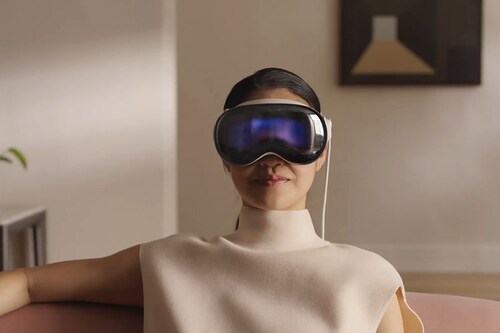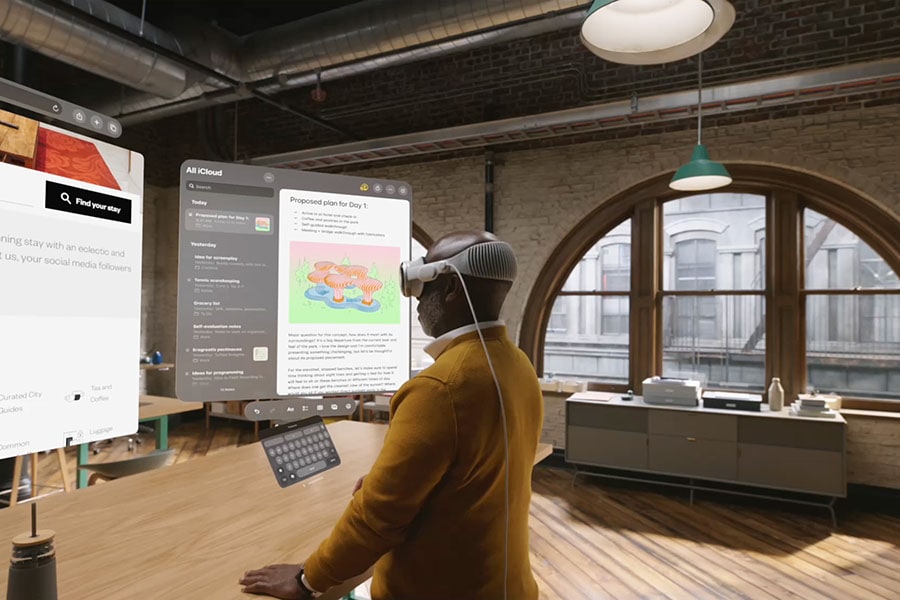Apple launches its own augmented reality headset at WWDC23
Barging into the market dominated by Meta, Apple's new offering is grabbing eyeballs, but its price remains a pain point


Apple unveiled an augmented reality (AR) headset called Vision Pro on Monday at its annual Worldwide Developers Conference (WWDC). After years, the company launched its most ambitious and riskiest hardware product post the launch of the iPhone over a decade ago. In a market that is dominated by Meta, the price of Apple’s headset is more than three times the cost of Meta"s line of mixed and virtual reality devices. Apple is calling Vision Pro a new kind of computer: Spatial computing and its starting price is $3,499 (Rs288,025).
Calling it the world’s first spatial operating system, Apple CEO Tim Cook said, "It"s the first Apple product you look through, not at." The device has a Black Mirror-like feature: A 3D camera that promises to allow users to capture memories with spatial audio so that they can relive them, like living it in the moment. Basically, Apple’s Vision Pro blends digital content with the physical world while allowing users to stay present and connected to others. Just like having your own personal TV.The headset display boasts more than 23 million pixels, more than a 4K TV. The VR headset runs on Apple"s M2 chip, but also a new chip called R1, which processes the masses of data involved, including input from 12 cameras and sensors that face forwards, downwards, and inwards on your eyes. It"s been designed to reduce lag and avoid motion sickness. The device will work all day plugged in, but only for two hours on the battery, which is connected to it through a long cord of wire.
This model is too niche from a pricing perspective. The use cases for mixed reality (MR) till now are limited to a few enterprise use cases in a few industries like health care, R&D, etc, explains Navkendar Singh, associate vice president, IDC India. "Beyond these few niche use cases, MR/AR/VR haven’t really been able to appeal to a larger consumer base. Vision Pro will appeal to developers, creators, and maybe a few niche, limited entertainment avenues."
 With Vision Pro, apps can fill the space around users, be moved anywhere, and scale to the perfect size. They even react to lighting and cast shadows Image: Apple
With Vision Pro, apps can fill the space around users, be moved anywhere, and scale to the perfect size. They even react to lighting and cast shadows Image: Apple
The Vision Pro operating system is controlled by hand and eye movement, and navigation. It will track and reveal our eyes to others using a feature called EyeSight. The exterior screen goes dark when a user is fully immersed in a virtual world. When a person approaches a user who is in full virtual mode, the headset will show both the user and the outside person to each other, something that Meta’s headsets don’t offer at the moment. However, Facebook-owned Meta currently controls nearly 80 percent of the market for AR/VR devices, according to market research firm IDC.
This augmented reality headset that blends virtual reality with the real world will be available early next year in the US, with more countries coming later in 2024. The announcement didn’t quite excite Wall Street. Investors weren’t sure about Apple’s headset, which led the company’s shares to dip by 0.76 percent on June 5.
At its annual developer conference happening at its Cupertino, California, headquarters, Apple also introduced a tranche of new products and features, including a 15-inch MacBook Air, a chip called M2 Ultra, improvements to its iOS software, a much-awaited improvement to prevent its autocorrect, voicemail transcription, a ‘Check In’ safety feature, and more. Vision Pro stole the show though.
Having said that, these devices raise a lot of questions about their impact on health. Shlok Shrivastava, a tech reviewer and influencer, has a polarised view on Apple’s newest gadget. "It is going to be a game changer, and it will revolutionise the industry because the existing AR/VR headsets are great, but lack comfort and good-quality screens. At the same time, I think the headsets can prove to be a disaster because having a personal TV just centimetres away from your eyes is not healthy. So, I don"t know what health problems [these] might have [on the user]."
Using these headsets for prolonged hours makes the user dizzy, their eyes start to blur out, and they get very uncomfortable. "I don"t know how that can be solved because putting screens that close up to the eyes has an adverse effect on health. Apple also didn"t talk about the health aspect of this product in their presentation. So, I would be surprised to see how they fix it because this is the biggest challenge when it comes to AR. But I"m very excited to see technology moving forward," says Shrivastava.
> Made in China to Make in India: Apple"s new big bet
> Steve Jobs, spirituality, and now Tim Cook: Why Apple sees India as "glass half full"
First Published: Jun 06, 2023, 14:39
Subscribe Now